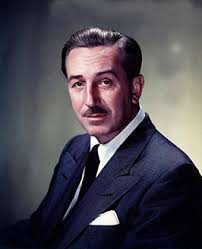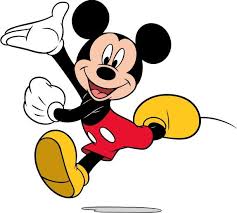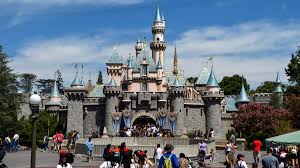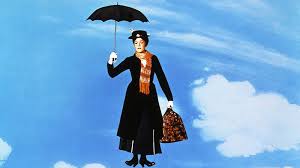
The material below is
largely based on a published work “Walt Disney – The Triumph of American
Imagination” by Neal Gabler and published in 2006. Other resources have also
been utilised. No passages have been quoted directly.
WALT DISNEY
–IMAGINATION UNLIMITED

All he wanted to do was draw. And make people laugh. He began modestly as a
commercial artist and quickly moved on to a company that produced very basic
animation for cinema advertising together with slides and movie film. His eyes
were opened. His imagination fired. He wanted to be an animator. And he achieved
his ambition before he turned 20. He went on to invent memorable cartoon
characters, utilised animation techniques that drew the audience deep into the
action, risked all to produce the world’s first full length animated feature;
made great use of television when other animators saw it as a threat; moved into
live-action films and opened a theme park where larger than life Disney
characters interacted with visitors of all ages.
Disney cartoons sparkled. They were colourful and funny. The characters brimmed
with life and personality and were loved the world over. But their creator’s
journey from rags to riches was anything but smooth. He began animating
professionally at the age of 19 but was over 60 before he became a wealthy man.
STUMBLING START
Walt Disney had spent a blissful early childhood in Marceline, Missouri after
moving there at the age of four. He had been born in Chicago on 5 December, 1901
and in 1911 the family moved to Kansas City where Walt’s life became much more
burdensome, especially delivering early morning newspapers through harsh
winters.
By this time he had shown a strong interest in two things: drawing and
performing comedy acts. His early dream was to become a performer but long
before his teenage years he set his sights on cartooning – inspired by watching
newspaper cartoonists at his “place of work”, the Kansas City Star.
In 1917 yet another move took the family back to Chicago, and from there Walt
spent a year away from home training for wartime ambulance work in France.
His two brothers moved back to Kansas City and Walt followed them, securing his
first job as a commercial artist. His delight knew no bounds. He would be paid
to engage in the activity he had relished since childhood: drawing pictures. He
did the rough sketches for advertisements and catalogues which his bosses would
finalise and lay out.
He was “made redundant” after a few weeks, having been employed largely to deal
with the pre-Christmas advertising rush. He took a brave step and formed a
commercial artwork partnership with Ub Iwerks, who had also been laid off by the
same company and would later also become a top-class animator, initially working
for Disney. Soon after forming the partnership they decided by mutual agreement
that Walt should apply for a vacancy in the Kansas City Slide Co (he got the
job), while Iwerks ran their shop. The slide company made advertising slides for
cinemas and also did live action adverts and a small amount of very crude
animation. In the event Iwerks did not have the required business skills to
maintain the partnership successfully so it was closed down and Iwerks also got
a job at the slide company.
This could be deemed the beginning of Disney’s workaholic career in animation.
He was utterly fascinated by the process of making things move on film, and
being in total control of the action. His paid job was only part of his
extremely active life. He set up an experimental studio in a garage behind his
parents’ house (they had just returned to Kansas City from Chicago) and, largely
on borrowed money, was able to make experimental animated films. Borrowing was
his modus operandi well into his career – and even when his work became
profitable the money was all ploughed back into the next project, studio
improvements or extra staff.
On top of his paid job and home experiments he attended the local Art Institute
to deepen his artistic knowledge (he had studied there at the age of 14), and he
also obtained and studied samples of the work of pioneer animators. Motion
picture animation had been undertaken as early as 1900 but had made little
progress.
In 1915 a “newspaper cartoonist turned animator” (Earl Hurd) had patented a new
method of cartooning – cel animation. This labour-saving device had the moving
figures drawn on clear celluloid with the static background visible through it.
Disney tried to introduce this at the slide company but the bosses preferred to
stick with their traditional method of doing complete drawings for each frame.
Disney took a bold step and offered one of his experimental reels to a cinema
owner along with a promise to produce more material. As a result he was
contracted to supply a series of “Laugh-o-grams” – short satirical cartoon
sketches. The first Laugh-o-gram was screened on March 20, 1921. He had entered
the world of professional animation. He was only 19.
But with youth comes inexperience. He established a studio (Laugh-O-Gram Studio)
later in 1921, employed staff and set about animating popular fairy tales,
beginning with Little Red Riding Hood. The cartoons were popular in the cinema
but returned very little money and the studio was forced into bankruptcy. It was
a lean period for Disney – he was sleeping in his office, bathing at the railway
station and often going without meals. He knew he would have to make a new start
and what little income he received went into developing a new project rather
than paying off creditors. It eventually brought his career back on track. His
new idea was to combine live action with animation. Called “Alice’s Wonderland”,
it featured a 4 year old child, cartoon animals and animated moving objects.
After completion, it received a reasonable reception thanks to the professional
skills of a Hollywood distributor named Margaret Winkler. The project prompted
Disney and his brother Roy to move from Kansas City to Los Angeles in 1923. They
initially operated as Disney Brothers Cartoon Studio, changed to Walt Disney
Studio in 1926 and Walt Disney Productions in 1929.
“Alice” became a series with Disney committed to delivering one film
every two weeks by 1925. Things were looking up.
BUSINESS DEALINGS
Disney signed a contract with a businessman named Charles Mintz. Through him the
Alice films were secured for a lengthy period and a deal with Universal was
negotiated featuring a character called Oswald the Lucky Rabbit. Initially,
there were problems and Universal refused to release the cartoon but Walt
redefined Oswald – making the jokes
emerge from the rabbit rather than using the character as a background on which
to paste individual gags. The series became a success and Disney now had a
reputation with a major studio.
With contractual obligations requiring him to deliver regular product he was now
employing a sizeable staff (22, all men). His single-minded obsession with his
projects worked to the detriment of relationships with his employees and their
welfare but he never considered any likelihood of disloyalty, especially as work
for animators was scarce. More seriously, he was unaware that Charles Mintz had
decided that the Oswald cartoons could continue to be made without Disney. A
double betrayal occurred early in 1928. A new three year contract to continue to
supply Oswald cartoons was drawn up between Mintz and Universal while, unknown
to Disney, his animation staff were also being invited to sign contracts
directly with Mintz. Meanwhile, Disney had drawn up three year contracts for his
staff to sign, and also contracts to supply Oswald cartoons which he was
planning to offer to other studios. MGM turned him down, believing that cartoons
were going out of favour. His staff were not signing either. He then discovered
to his horror that Mintz and most of his own staff had negotiated a three year
contract to continue the cartoon series for Universal with Disney himself left
out altogether. He had been sidelined completely.
He still had a few loyal staff members, including Ub Iwerks. But he had to start
from scratch.
ENTER MICKEY MOUSE
Even before the double betrayal, Walt Disney was seeking a new character to
eventually replace Oswald the rabbit. Inspired by Charles Lindbergh’s 1927
flight across the Atlantic, he devised a mouse character who built a plane to
impress a lady mouse. Walt named the mouse Mortimer. His wife Lillian preferred
Mickey.

The new character was animated by Disney, Iwerks and about a dozen others
working after hours. He was something of a hybrid between downtrodden Charlie
Chaplin (Disney’s idol) and swashbuckling Douglas Fairbanks (Iwerks’ idol). The
first film “Plane Crazy” tended towards Chaplin, the second “The Gallopin’
Gaucho”, towards Fairbanks. Then came the big breakthrough – Disney decided the
third Mickey Mouse cartoon (“Steamboat Willie”) would be a sound film. He
experimented with a range of methods of sound synchronisation and the finished
film was shown to a preview audience in July, 1928 – a mere five months after
the problems with Mintz.
Eventually Mickey’s fame would know no bounds and he would become synonymous
with the entire Disney operation. In fact his face became their logo. But his
fame was not instantaneous. Disney and the team were still developing the art of
giving their creations personality. The character-based approach first
demonstrated with Oswald and further developed with Mickey appeared to come to
fruition with the animation skills of a Disney staffer named Fred Moore in his
work in the 1933 short cartoon “The Three Little Pigs”. For the first time the
characters were given real emotional depth. It was a colour cartoon, after
Disney had pioneered a new Technicolour three-strip colouring method in an
acclaimed remake of an earlier cartoon “Flowers and Trees” in 1932. Following
“Pigs x 3” Mickey Mouse was redrawn in colour, re-characterised and, from there,
quickly became the personality the world would fall in love with. A separate
business wing was set up to market Mickey Mouse merchandise and over the next
six years it gradually became a bigger money-earner than the films.
Other characters were introduced through the Mickey cartoons (most famously
Minnie Mouse, Pluto and Goofy), but a quite different, and equally successful,
Disney money earner in his years exclusively devoted to the cartoon short
(1928-1936) was a series named “Silly Symphonies”. These began in 1930 at the
suggestion of music composer Carl Stalling, by which time all the Mickey Mouse
cartoons were sound films. The idea was to take a musical composition and
animate characters or objects to it. “The Skeleton Dance” was the first, human
skeletons dancing in unison. The series eventually took off and Disney was
turning out one Silly Symphony per month, alongside one Mickey Mouse every two
or three weeks.
As with “Alice” and “Oswald”, Disney required the services of a distributor. He
contracted Pat Powers to distribute Mickey Mouse but was himself able to strike
a “Silly Symphonies” deal directly with Columbia, a studio not yet in the big
league (with MGM, 20th Century, Universal, Paramount, Warner Brothers
and RKO), but on the rise.
Powers appeared to be on the brink of betraying Disney as Mintz had done but
Disney was able to extricate himself (at some cost to both himself and Columbia)
and allocate to Columbia the full distribution rights for both Mickey Mouse and
the Symphonies.
Late in 1930, with the deal only months old, Disney felt he was being
short-changed by Columbia both in terms of their accounting and of their
promotional work. The studio appeared to be assuming Mickey and the Symphonies
were popular enough to do their own self-promotion, thus denying the cartoons
their full potential. Disney conducted covert negotiations with United Artists -
the elite grouping started by WC Fields, Douglas Fairbanks, Mary Pickford and
Charlie Chaplin. He secured an agreement for UA to take over distribution when
the Columbia contract expired in April, 1931.
Though only 29, Walt Disney was now walking among Hollywood’s biggest stars.
By 1934 it was feared, despite his recent makeover, that Mickey Mouse might be
starting to lose the freshness and wide appeal he enjoyed when first launched in
1928. He was now thought (quite wrongly) too “proper” to endure forever. Disney
decided a new character was required – a sillier, naughtier one.
Enter Donald Duck!!
With the instantly popular Donald now on board, along with Daisy and nephews
Huey, Dewey and Louie (all within the Mickey Mouse contract) income from the
cartoons rocketed and the early 1930’s were highly lucrative for Disney and his
brother and business manager Roy, despite the world-wide financial Depression
raging at the time. Roy had worked tirelessly behind the scenes, shunning the
limelight, since the business was established in
1923.
NEW HORIZONS
As early as 1933 Walt Disney was, as usual, looking beyond Mickey for a new
project and decided he was ready to attempt a full-length animated feature. He
invited suggestions for a story and was inundated: “Alice in Wonderland”,
Homer’s “Iliad”, “Gulliver’s Travels” among a multitude of starry-eyed
proposals. But Disney had already made up his mind. “Snow White and the Seven
Dwarfs” was a traditional fairy tale, retold by the Brothers Grimm, turned into
a play and filmed as a live action story in about 1916. It would now have yet
another incarnation – the world’s first fully animated feature film, and in
colour.
The project became an obsession for Disney. A massive amount of experimentation
took place to arrive at the best animation style, characterisations and story
treatment. Disney poured his entire resources into it. But he was confident
enough to utilise an innovative system of animation in which several cels were
photographed at varying depths in relation to each other. The method was tested
on a random “Silly Symphony” and used throughout Snow White to give the
impression the audience was moving right into the action. It was highly
effective, but expensive and time-consuming.
The production raced towards its deadline. The Disney brothers, desperate for
money throughout, had secured a distribution deal with RKO. They felt, or at
least Walt felt, United Artists were too small to carry the sort of clout
required for the distribution of the world’s first animated feature.
Snow White required 250,000 drawings and 200
years of man-hours. The premiere took
place on 21 December, 1937. To Disney’s enormous relief it was widely acclaimed
and made a substantial profit. Secretly he had never really doubted Snow White.
In fact, long before it was completed he was already onto his next project –
classical music accompanying largely abstract animation. Polish conductor
Leopold Stokowski collaborated and the result (after a vast amount of
disagreement regarding musical interpretation and animation styles) was
“Fantasia”.
The floodgates opened. While Fantasia was in production, Pinocchio was completed
(after much agonising over characterisation), and Bambi was also being worked
on, though by a group in a different building and, until near the end, entirely
independent of Walt Disney’s influence. There were major delays with it – as
indeed there had been with Fantasia and Pinocchio. All three were worked on
simultaneously. Two further features were produced very quickly while the other
three were in production: “The Reluctant Dragon”, a Robert Benchley story made
into a largely live-action feature with a little animation; and “Dumbo” a
ready-made story ideal for animation and largely done by the artists who had
animated the elephant sequence in Fantasia (Dance of the Hours).
Thus, after Snow White, Disney’s next five features were completed in just three
years, despite the delays: “Pinocchio” and “Fantasia” (1940); “The Reluctant
Dragon” and “Dumbo” (1941); Bambi (1942). Only Snow White quickly recouped its
costs - the others did not. Most of them, especially Dumbo, received
considerable acclaim but the response was diluted by criticism as well, seeing
the sometimes dark realism in Dumbo as an unfortunate contrast to the joyful and
humorous fantasy of Disney’s early work – especially now that the country was at
war.
The financial problems resulting from the box office failures were exacerbated
by a crippling strike by animators in 1941 which ultimately led to several heavy
cut-backs in Disney’s employee numbers. They had peaked during and after Snow
White at about 1,200.
Coinciding with Disney’s “post Snow White” financial problems was an increased
interest by American politicians and business leaders in relations with South
America. Disney travelled there and the trip led to a number of South American
themed cartoons, and eventually two features (“Saludos Amigos” and “The Three
Caballeros”) being produced in the Disney’s Los Angeles studios. The studios had
been located at Hyperion Avenue since the Disneys moved to Los Angeles, in a now
sprawling complex resulting from constant additions.
A
major change for Disney during the war was a virtual take-over of the studio by
the United States government. He was asked to make defence training films
(nearly all animated), and other short films - effectively becoming an employee
of the State. Although this was an uncomfortable situation for Disney, it was an
absolute life-line as the studio would almost certainly have been forced into
bankruptcy but for the work provided by the partnership with the government. A
much acclaimed and ground-breaking feature “Victory Through Air Power” came out
of this relationship – animation combined with a live presentation by a
boisterous Russian crusading for air power, Alexander de Seversky,
Times were hard for Disney after the war. Government work ceased, insufficient
money was coming in from the features, and new opposition was emerging from
other studios whose animation wings were in the ascendancy. MGM had introduced
Tom and Jerry in 1940, but the most serious rival was Warner Brothers whose
Merrie Melodies and, later, Loony Tunes series became raging success stories.
Among others, Daffy Duck, Porky Pig, Elmer Fudd and, most famously, Bugs Bunny
emerged from the Warner stable. Bugs was first introduced in a 1943 send-up of
Fantasia, Bob Clampert’s “A Corny
Concerto” where a rabbit pranced around as a ballerina.
Two features produced in 1950 saw fortunes change for Disney. “Treasure Island”,
his first full live-action feature, became the first profitable venture for a
long time and “Cinderella”, in gestation since 1943, proved to be a milestone in
the same league as Snow White, both in terms of profitability, and of the
dedication and enthusiasm shown by Disney and the studio generally. Cinderella
cost $2.2 million and grossed $7.9 million excluding money made by the hit song
“Bibbity Bobbity Boo”, and general Cinderella merchandising.
DISNEYLAND
Still seeking new horizons, Disney turned his main attention (and money) away
from movies altogether in the early 1950’s. The Disneyland theme park story
began when Walt’s ebbing enthusiasm for his film studio in the late 1940’s
diverted his energy into a new hobby – model trains. This led to him building an
entire miniature village, then to designing mechanical people – and finally to
the grand vision of a theme park. It was designed more as a movie set, with
patrons moving from scene to scene. The venture became an obsession for Disney
and it was to be a separate operation from Walt Disney Productions. The idea
itself probably dates back as far as 1937 (Snow White days). A vast range of
options regarding the design, function and location of the park occupied Disney
from 1950. Land was eventually purchased in September, 1953; the ground broken
on 12 July, 1954 and the park opened on 17 July, 1955. Its success was
instantaneous.

Finished movies were steadily being released after Cinderella and the Disney
brand was known the world over. Another favourite that was in the pipeline as
early as 1940 and eventually released in 1953 was “Peter Pan”. In October, 1954
Disney moved into television. The other major studios would stay clear of it for
at least another ten years, seeing the medium as a rival rather than an ally.
Also in 1954 the Disneys broke from RKO and set up their own distribution
company Buena Vista. The name was taken from the street facing the studio.
The Mickey Mouse Club (a half-hour daily television programme) took Disney into
colour. A weekly hour-long programme called Disneylandia was already running.
The only Disney phenomena to ever seriously rival the merchandising frenzy of
their famed mascot Mickey Mouse was Davy Crockett. It began with three TV
episodes and concluded with two features in 1955 and 1956. Ten million Davy
Crockett coonskin caps were sold world-wide. Other memorabilia included shirts,
rifles, knives and jackets, and the theme song sold seven million copies in the
first six months of its release. Simple, catchy songs had been a key feature of
Disney’s work ever since Snow White’s dwarfs sang “Hi-Ho!!”
The mid-1950’s saw the short Disney cartoons made for cinema finally grind to a
halt – a victim of the impact of television. The features continued and a
bizarre experiment was attempted with “Sleeping Beauty”, released in 1959. The
animation changed to a flat, two dimensional style in imitation of the
contemporary art scene and in response to the rivalry shown by the short-lived
UPA (United Productions of America) and their innovative blind cartoon
character, Mr Magoo. Huge money was sunk into “Sleeping Beauty”, in production
since 1951. It was a financial failure.
However by 1960 feature films made up only 38% of Disney’s revenue. Television
brought in 28%, Disneyland 21% and merchandising 13%. But in 1961 two
live-action hit movies made profits of around $8 million each: “The Absent
Minded Professor” with Fred MacMurray and “The Parent Trap” with a young Hayley
Mills playing identical twins.

Disney worked on several community type projects in 1965 and 1966, including an
art academy, a ski resort, and by far his most ambitious: a self-contained city
outside the proposed Florida Disney World.
Walt Disney was still bursting with ideas when he was stricken with lung cancer.
It developed rapidly and led to his death on 15 December, 1966.
He was 61. His ashes are interred outside the Freedom Mausoleum at Forest Lawn
Cemetery, Glendale, California – close to the Disney studio.
His name, studio and Disneyland have endured and remain as institutions into the
21st century. Some of his earlier film failures became profitable on
re-issue. By 2010 the Disney business conglomerate employed 140,000 people, had
moved into interactive video gaming, publishing, ownership of other studios
including Pixar, 20th Century and Searchlight, and operated fourteen
theme parks throughout the world. It owns ABC television network and multiple
cable channels including the sports network ESPN.
Walt Disney was a driven man. As each goal was reached he looked for another.
More life-like animation; a world famous cartoon character; cartoons with sound;
colour cartoons; multi-plane animation; an animated feature; colour television;
Disneyland – all were world firsts. He could not sit back and enjoy his
successes. He had to either improve them, or leave them in the care of others
while he moved on to something new. His company produced 73 feature films in his
lifetime, all marked with his distinctive personal style. His politics and
philosophy of life somewhat contradicted each other. Although strongly
anti-communist and a staunch Republican (even to the extent of raising money for
Barry Goldwater’s 1964 Presidential campaign), he was never a materialist and
never hoarded money. He was an internationalist, was against class distinction,
showed concern for the underdog, and his work always expressed a love of
innocence, humour, childhood curiosity, and good clean American fun.